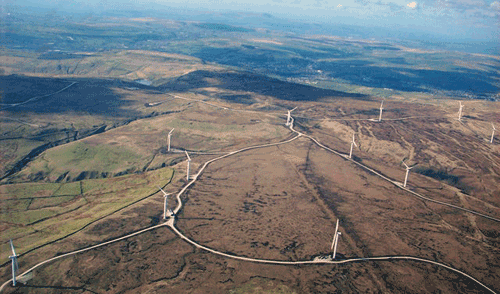 The Scout Moor Wind Farm is situated in Northwest England in the West Pennine Moors of Lancashire. It is the largest on-shore wind farm in England, producing enough energy (154,000 MW-h/yr) for 40,000 homes. Like many wind farms, the space and weather conditions are ideal for harvesting wind power; but access to the site and establishing firm turbine footings is a challenge.
The Scout Moor Wind Farm is situated in Northwest England in the West Pennine Moors of Lancashire. It is the largest on-shore wind farm in England, producing enough energy (154,000 MW-h/yr) for 40,000 homes. Like many wind farms, the space and weather conditions are ideal for harvesting wind power; but access to the site and establishing firm turbine footings is a challenge.
In the case of the 65MW, 26-turbine Scout Moor farm, it was constructed upon 1,347 acres (545 ha) of an extensive peat bog.
Providing an additional challenge to the site’s ability to support and sustain that heavy loads of site truck traffic and the large turbine towers, the site is underlain by six coal seams and a number of abandoned, shallow mines.
Altogether, 12 km of roads were planned to ensure access. Germany-based geosynthetic consultant BBG Bauberatung Geokunststoffe GmbH & Co. KG carried out the design of the roads and 26 crane pad construction areas. A “floating road” construction–essentially, a linear load transfer platform–proved to be the right solution, as it took into consideration the various site constraints as well as issues of constructability, design life and economics, all of which played a significant role in the final decisions.
STRONGER ROADS, LESS AGGREGATE
The very low shear strength parameters of the subgrade, together with the potential collapse of mining voids in the area, required road reinforcement to prevent bearing failure. Geogrids were selected as the most suitable reinforcement material. They provided a relatively low cost solution when measured with constructability and ecological impact on the peat bog environment. The improved load-distribution behavior of the geogrid-reinforced aggregate layers meant stress concentrations over the soft peat layers were reduced. This minimized differential settlements at the road surface. Also, it reduced the quantity of aggregate needed. In the United Kingdom, aggregate taxes can heavily affect project budgets, much in the way that suitable aggregate availability impacts project budgets elsewhere.
For the 4.5m-wide access roads, two layers of 4.75m-wide Secugrid® were installed along the length of the road. This represented a significant time (and cost) savings over the original design, which had called for 4m-wide geogrids that would be installed across the road width.
Secugrid® was identified as a technically equivalent and economically superior alternative; and the project was built within the scheduled time frame.
Approximately 500,000 m2 of Secugrid® geogrids with tensile strengths from 30 kN/m to 400 kN/m were utilized for the project.
 |
This article first appeared in NAUE News. Learn more about NAUE’s geosynthetics at www.naue.com. See also, www.secugrid.com.











